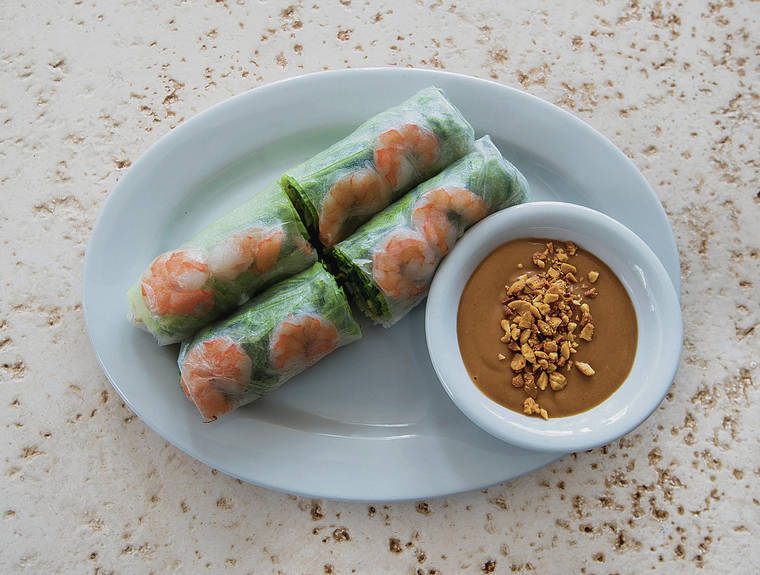While arguments continue over the value of wearing or not wearing masks and over the validity of drug claims in treating COVID-19 Opens in a new tab, I don’t think anyone would contest the wisdom of eating the right foods to boost the immune system, so far the body’s only defense during the pandemic.
A quick rundown of social media posts shows people are enjoying a plethora of comfort meals built around fatty foods, meat and desserts, which do the body no favors. For those interested in arming their defense cells for a potential life-or-death battle, here are some more healthful options next time you make a takeout run.
CHINESE
It can be hard to cut through the fat, salt and starchiness of Chinese food, but dim sum can be a good bet if you stick to sheer-wrapped veggie- filled dumplings.
If you can find jai, this Buddhist vegetarian stew popular at the Lunar New Year comprises ingredients such as mushrooms, gingko nuts and bamboo shoots, all associated with the blessing of, surprise, long life.
JAPANESE
The Japanese menu is full of healthful ingredients such as fish, seaweed and miso, but one of its most nutritious is natto, those slimy, fermented soybeans that people love or hate. I’m in the latter category, but I will have to reconsider because natto’s benefits may outweigh my aversion to its stinky, sticky character.
Natto is full of vitamins B1, B2, C and K2, plus significant amounts of such minerals as magnesium, calcium, potassium, zinc, selenium, manganese, iron and copper. It’s also a probiotic that helps with digestion and absorption of nutrients.
Also worth seeking out are low- sodium seaweed soup and water-and-konbu based hot pots with more veggies thrown in than meat.
KOREAN
In addition to the benefits of eating lots of kim chee and garlic, Korean cuisine also offers an equivalent to the American cold remedy, chicken soup.
Samgyetang is a ginseng soup with a centerpiece of a small whole chicken stuffed with rice and such medicinal and vitamin-packed ingredients as garlic, gingko nuts, red dates and chestnuts. To keep sodium content low, diners add their own salt at the table, to taste.
The hot broth retains the minerals and proteins from the ingredients. For this reason, the soup is believed to restore energy, particularly popular in summer as a way of replacing nutrients lost to perspiration when the weather turns warm.
THAI
Green papaya salad is a staple at the Thai table and a great addition to any meal because it’s high in fiber, low in cholesterol and fat free. It’s virtues start with the green papaya, which contains high levels of vitamins C, E, A and folate, as well as magnesium, potassium, calcium, iron and other antioxidants.
The shredded green papaya is pounded and tossed with garlic, a source of minerals and vitamins C and B6; tomatoes that provide vitamin C, alpha and beta carotene, lutein and lycopene; plus fish sauce, deemed a healthier way to get your salt fix because of its vitamin and iodine content and antioxidant properties. For those who need to reduce sodium in their diets, less fish sauce than salt is required to enhance food flavors because of the umami character of the fermented condiment.
VIETNAMESE
From pho to vegetable-filled rice vermicelli bowls, Vietnamese cuisine is considered one of the most healthful, if you steer clear of barbecued meats.
One dish to look for is goi cuon, summer rolls typically filled with herbs, vegetables and shrimp, for a dash of color peeking through the opaque rice-paper wrap. It’s essentially an elegant hand-held salad.
Although shrimp is associated with cholesterol, I don’t think a trio of shrimp halves would do much harm, but the more militant could opt for tofu or all veggies instead.
Also, few would consider chicken salad to be very exciting, but the Vietnamese version, goi ga bap cai, delivers an explosion of flavor, due to its combination of shredded chicken and cabbage tossed with pickled vegetables, basil, cilantro, garlic, chopped peanuts, fish sauce and more. It’s a perfect package for anyone who wants food both nutritious and delicious.
MEXICAN
This cuisine has a reputation for being fat- and carb-centric, but there are options. On the higher end, you’ll find Veracruz-style white fish prepared with tomatoes, olives and capers, served over rice.
Order vegetables or fish when you can find them, and instead of refried beans, opt for black beans, a good source of antioxidants, magnesium, potassium and fiber that can help with digestion.
Fish tacos can be one of the healthier items on the menu, but make sure the fish is grilled or sauteed, and avoid the deep-fried Baja version.
Nadine Kam’s restaurant reviews are conducted anonymously and paid for by the Star-Advertiser. Reach her at nkam@staradvertiser.com.

